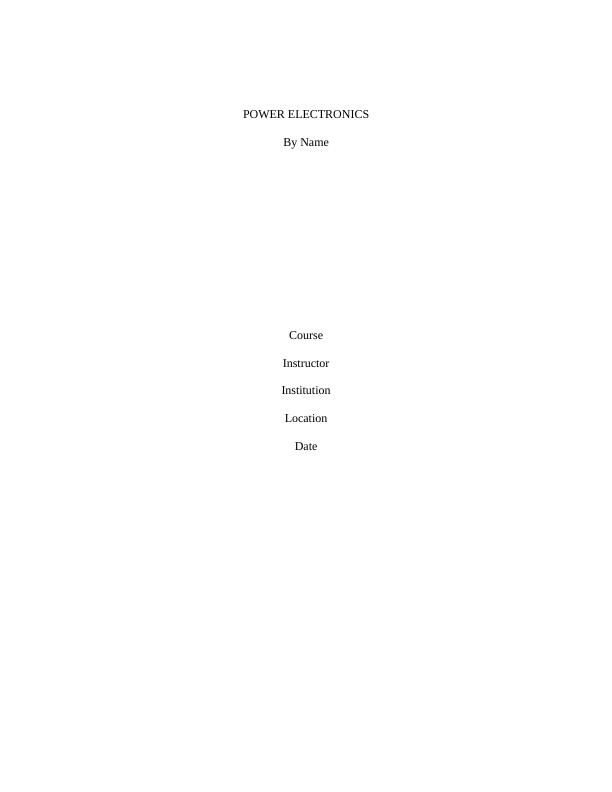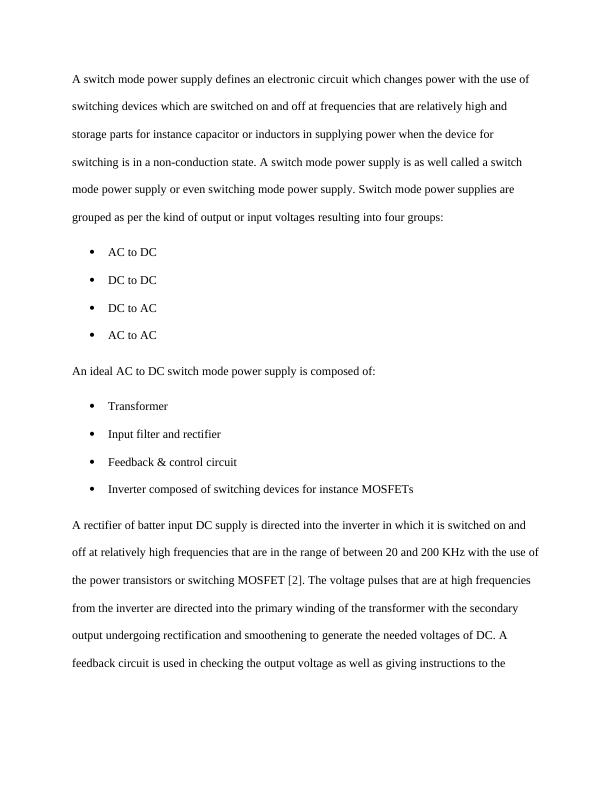Switch Mode Power Supply and its Types
Added on 2022-10-19
9 Pages1316 Words416 Views
POWER ELECTRONICS
By Name
Course
Instructor
Institution
Location
Date
By Name
Course
Instructor
Institution
Location
Date

A switch mode power supply defines an electronic circuit which changes power with the use of
switching devices which are switched on and off at frequencies that are relatively high and
storage parts for instance capacitor or inductors in supplying power when the device for
switching is in a non-conduction state. A switch mode power supply is as well called a switch
mode power supply or even switching mode power supply. Switch mode power supplies are
grouped as per the kind of output or input voltages resulting into four groups:
AC to DC
DC to DC
DC to AC
AC to AC
An ideal AC to DC switch mode power supply is composed of:
Transformer
Input filter and rectifier
Feedback & control circuit
Inverter composed of switching devices for instance MOSFETs
A rectifier of batter input DC supply is directed into the inverter in which it is switched on and
off at relatively high frequencies that are in the range of between 20 and 200 KHz with the use of
the power transistors or switching MOSFET [2]. The voltage pulses that are at high frequencies
from the inverter are directed into the primary winding of the transformer with the secondary
output undergoing rectification and smoothening to generate the needed voltages of DC. A
feedback circuit is used in checking the output voltage as well as giving instructions to the
switching devices which are switched on and off at frequencies that are relatively high and
storage parts for instance capacitor or inductors in supplying power when the device for
switching is in a non-conduction state. A switch mode power supply is as well called a switch
mode power supply or even switching mode power supply. Switch mode power supplies are
grouped as per the kind of output or input voltages resulting into four groups:
AC to DC
DC to DC
DC to AC
AC to AC
An ideal AC to DC switch mode power supply is composed of:
Transformer
Input filter and rectifier
Feedback & control circuit
Inverter composed of switching devices for instance MOSFETs
A rectifier of batter input DC supply is directed into the inverter in which it is switched on and
off at relatively high frequencies that are in the range of between 20 and 200 KHz with the use of
the power transistors or switching MOSFET [2]. The voltage pulses that are at high frequencies
from the inverter are directed into the primary winding of the transformer with the secondary
output undergoing rectification and smoothening to generate the needed voltages of DC. A
feedback circuit is used in checking the output voltage as well as giving instructions to the

control circuit to make adjustments to the duty cycles to keep the output at the levels that are
desired.
The various types of switch mode power supplies include:
Forward converter, in which, the current is carried by the choker when transistor is under
conduction and when it is not. The current is carried by the diode during the period of an off in
the transistor hence the flow of energy into the load during the two periods.
Fly back converter involves the inductor magnetic field storing the energy in the on period of
switch. The energy is drained into output voltage circuit in an open state of the switch. The
output voltage is determined by the duty cycle.
DC to DC converter: The reception of the primary power from AC main undergoes rectification
as well as filtration in the nature of high voltage DC which is thereafter switched at a very high
speed and channelled into the primary divide of a step-down transformer. The step down
transformer is just but an inch of the size of a 50 Hz unit that may be used for comparison hence
sorting the problems of size and weight. It is thereafter channelled to power supply output and a
sample of the output is resent to the switch to regulate the voltage of the output.
Self-oscillating fly back converter works on the principle of fly back such that during the time of
connection of switching transistor, the current via the primary of the transformer begins ramping
up in a linear manner during the slope is equivalent to Vin/Lp. The induced voltage in secondary
winding and feedback winding result in fast recovery rectifier reverse biased and keep the
conducting resistor in an on state. When a peak value Ip is attained by the primary current in
which the core starts saturating, there tends to be a sharp rise in the current. The sharp rise is the
desired.
The various types of switch mode power supplies include:
Forward converter, in which, the current is carried by the choker when transistor is under
conduction and when it is not. The current is carried by the diode during the period of an off in
the transistor hence the flow of energy into the load during the two periods.
Fly back converter involves the inductor magnetic field storing the energy in the on period of
switch. The energy is drained into output voltage circuit in an open state of the switch. The
output voltage is determined by the duty cycle.
DC to DC converter: The reception of the primary power from AC main undergoes rectification
as well as filtration in the nature of high voltage DC which is thereafter switched at a very high
speed and channelled into the primary divide of a step-down transformer. The step down
transformer is just but an inch of the size of a 50 Hz unit that may be used for comparison hence
sorting the problems of size and weight. It is thereafter channelled to power supply output and a
sample of the output is resent to the switch to regulate the voltage of the output.
Self-oscillating fly back converter works on the principle of fly back such that during the time of
connection of switching transistor, the current via the primary of the transformer begins ramping
up in a linear manner during the slope is equivalent to Vin/Lp. The induced voltage in secondary
winding and feedback winding result in fast recovery rectifier reverse biased and keep the
conducting resistor in an on state. When a peak value Ip is attained by the primary current in
which the core starts saturating, there tends to be a sharp rise in the current. The sharp rise is the

End of preview
Want to access all the pages? Upload your documents or become a member.
Related Documents
Understanding Switch Mode Power Supplies (SMPS) and their Role in Efficient Electronicslg...
|31
|4511
|101
Report on Multism Designlg...
|28
|4086
|324
Switching Frequency Technology and Power Qualitylg...
|20
|5484
|72
ELEC6251 Assignmentlg...
|12
|1636
|141
The Buck Converterlg...
|5
|931
|58
The Need for Inverters and Their Application Areaslg...
|5
|861
|39
